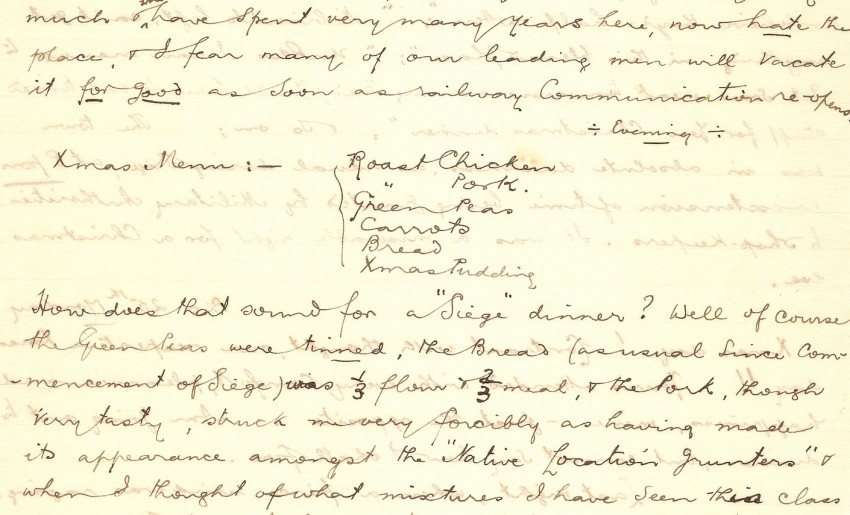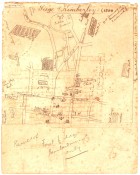Diary of Charles Ovendon Godden, a shopkeeper at Godden & Co, Kimberley at the time of the 124-day Siege of Kimberley. 203 numbered pages, 2 hand-drawn maps in a cloth folder and 2 permits issued to him.
Godden describes in great detail the military operations in and around Kimberley and gives the reader a thorough insight into daily life in the town during the Siege. The diary starts on a letter head of his business - Godden & Co on 14 October, 1899. The last dated entry on 18 February, 1900, three days after the Siege ended, is followed by a three-page ‘conclusion’. The diary, in his words is a ‘War’ letter that he addressed to his father, and he committed himself to daily observations.
Godden understood the historical context he found himself in and reported with authority on military maneuvers. He describes Boer positions, movements and tactics in areas around Kimberley like Spytfontein, Scholtz’s Nek, Belmont, writes about contact between Relief troops and Boers in places further afield like Magersfontein, Jacobsdal etc, updates on the Siege of Mafeking are also provided. He frequently reports on casualties on both sides, describes the shelling of Kimberley in much detail as well as the destruction it caused and how it affected the residents. There is also occasional references to amusing incidents.
Some extracts from the diary:
Godden was quite outspoken about the Boers, their strategies and tactics:
“Today (Sunday) the Boers are apparently praying for assistance, chewing their ‘Biltong’ as their guns are not to be heard.”
A “personal friend”, captured and subsequently released was told by the Boer Commando that “he could go to Kimberley as that was their Parliamentary centre as soon as the war was over.”
“Occasionally one sees a traitor being marched through the streets…”
“… the (Kimberley) rebels ought to be shot stone dead.”
“… these 28 (Boers caught) miserable-looking, scraggy-bearded, half startled specimens of uncivilized humanity passed by my place".
“… when our troops reached them, as usual, hoisted the white flag unsurrendered. After having hoisted the flag, they actually wounded three of our men - another dastardly act of the Boers.”
“A friend of mine was shot after the hoisting of White flag”.
“After the Modder River (Magersfontein) fight 104 dead Boers were taken from the bottom of the river, where often being wounded, their comrades had thrown them to end their misery! They each had heavy stones tied round their necks!!”
“Lt Col Scott… was shot within 60 yards of the enemy by an explosive bullet, which in civilized warfare is not allowable!”.
“19 bodies with a bullet wound in the forehead… It is firmly believed that these poor unfortunate 19 must have been taken prisoners and then shot.”
“The Boers again demonstrated their uncivilized mode of warfare by firing on an ambulance party when bringing in the wounded.”
Many references are made to Cecil John Rhodes who arrived in Kimberley just prior to the destruction of the railway line, and the involvement of De Beers Company during the Siege.
“Soon after Mr Rhodes arrived here, on being questioned as to the safety of the place, replied “Oh! I feel as safe here as I should in Piccadilly.”
“A shell fell in the Du Toitspan Road ‘just one minute before Cecil Rhodes passed in a cab!”
“Commandant Wessels ‘arranged’ to have whiskey with Rhodes the 15th, but failed to keep his appointment.”
“The military authorities are now turning out 50 shrapnel shells every day, each one stamped “with CJ Rhodes’ Compliments.”
“Considering everything, Mr Rhodes’ presence in Kimberley must after all be viewed as a God-send, for had he not been here, the fortifications of our town would have been very poor….”
“What Mr Rhodes has done for the town no-one outside of it can conjecture.”
“The soup is guaranteed to be free from horse flesh, the vegetables used are the free gift of Mr Rhodes.”
“De Beers Company placed about 6000 native ‘boys’ at the free disposal of the Military Authorities, who soon put them to work digging trenches and building forts constructed of red soil and sand-bags…”
“Some highly skilled mechanics and engineers, who, under military supervision can not only make shells, but when necessity demands, turn out a gun, excelling those manufactured in Paris.”
On the shelling of Kimberley:
“…. my place is right in the line of fire. De Beers offices, the Diamond Market and the Diamond Fields Advertiser’s offices are all aiming objects of the Boers, and all of these are in the same street as my premises!”
”I write today, in a fever of anxiety, hands and nerves shaking terribly. Terrific shelling took place today.”
“The screaming of the landlady and occupants of neighbouring houses was deafening and horrible.”
“… nothing remains to talk of but the defence of the town… we have been subjected to 10 days bombardment.”
“… picked up a piece of shell just after it exploded and “burnt my fingers slightly.”
“It is now 12 o’clock noon and so far today shelling has caused four deaths, 2 children, one of the remaining two being a daughter of a rebel.”
On food shortages during the initial stage of the Siege he noted: “Each person’s allowed 1 lb. bread per diem, and this is to be composed of 3/4 Boer meal and 1/4 flour. Meat is restricted to 1/2 lb. for each person per diem” No liquor, whatever to be sold to Natives… For the past month we have been drinking mud!”.
“The Boers have an unknown, but ingenious method of looting cattle… in less than three weeks there will be no more fresh meat….”
The food situation soon deteriorated: “To secure even a cow’s ‘trotter’ is a decided luxury” and on 9 January he reported “It was publicly announced this morning that the population must take horse flesh today, or nothing at all”.
On Censorship:
“The censorship of messages leaving Kimberley is now so terribly severe, owing to Lord Methuen’s instructions, the Reuter’s Special Correspondent here was not permitted to say that much distress exists among the women and children in Kimberley from want of proper food and anxiety….”
...
The diary of circa 40 000 words comes with two hand-drawn maps, one indicating the “result of first 6 days bombardment only” and another titled “Transvaal & O.F.S. War 1899-1900”. Pages are inserted loose in a decorative hand-made cloth folder. Pages have yellowed, some page edges worn, text complete and legible.
The diary comes with two permits: 1) Permit issued on 31 January, 1900, by Town Guard, which gives him permission to visit a mine to obtain a phonographic record of the firing of ‘Long Cecil.’ 2) Permit issued on 26 February, soon after the Siege had ended. It gives Godden permission “to return to Kimberley on conclusion of a visit to Cape Town.”
Charles Ovenden Godden was born on 1 December 1875 and died in May 1946. He was buried in Port Elizabeth.
- Sold By: Richmond Books and Prints
- Contact Person: John Donaldson
- Country: South Africa
- Email: [email protected]
- Telephone: 081 270 8827
- Preferred Payment Methods: Credit Card, Electronic Transfer & Paypal
- Trade Associations: AA Approved






























